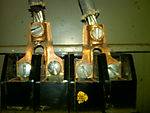Getting ready to put in my sub panel and clean up my messy electrical job. In previous ops, I always grounded my sub panel to the main panels ground but I had a separate ground and neutral bus bar. In this op, my main panel has neutrals and grounds tied together.
Do I need to run a separate ground rod? or just run my ground to the common bus bar? My sub panel has separate neutral and ground bus bars
Also any reason why I couldn't mount the sub panel sideways for space reasons?
Do I need to run a separate ground rod? or just run my ground to the common bus bar? My sub panel has separate neutral and ground bus bars
Also any reason why I couldn't mount the sub panel sideways for space reasons?







